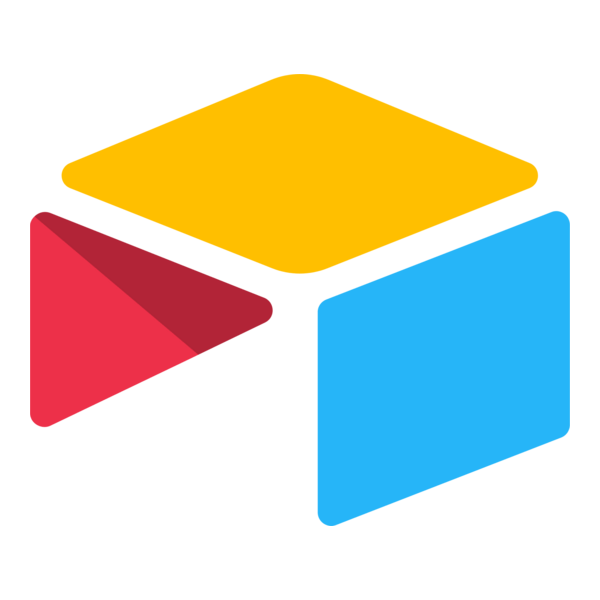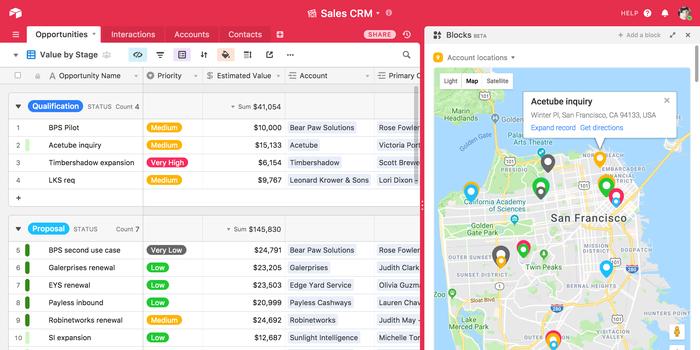
Airtable

Airtable
Cloud-based platform that combines spreadsheet ease with database power, offering flexible views, automations, AI, and 100+ integrations for any workflow.

Key Features
- Bases & Tables
- Multiple Views (Grid, Kanban, Calendar, Timeline, Gantt, Gallery)
- Interface Designer
- Automations & AI (Omni AI)
- Forms & Interface Forms
- Sync & Two-Way Sync
- Linked Records & Rollups
- Permissions & User Groups
- Apps & Extensions Library
- Revision & Snapshot History
What is Airtable?
Airtable is a low-code, cloud database that looks like a spreadsheet but functions like a relational system. Users build bases (databases) made of tables, fields, and linked records, then visualize data in customizable views or publish interactive dashboards with Interface Designer. Automations, AI-powered Omni assistants, and 100+ native integrations let teams replace siloed spreadsheets, legacy PM tools, and lightweight CRMs with a single, flexible platform.
Pros
- Spreadsheet-easy UI with database-level linking and rollups.
- Versatile views (Gantt, Kanban, Timeline, etc.) adapt to any workflow.
- Interface Designer & Omni AI build no-code apps and dashboards in minutes.
- Powerful automations and two-way sync with external apps/databases.
- Granular permissions (field, table, interface) plus SSO and admin panel on higher tiers.
Cons
- Per-seat pricing grows quickly as teams scale.
- Learning curve for advanced relational features and automation.
- Mobile experience less full-featured than desktop/web.
- Large datasets (>100 k records/base) require Business or Enterprise plans and new HyperDB.
Who It’s For
- Marketing, Product & Ops teams needing flexible project tracking.
- Start-ups & SMBs replacing siloed spreadsheets or lightweight CRMs.
- Enterprises requiring secure, scalable low-code apps with admin controls.
- No-code builders & agencies delivering custom client solutions.
- Developers & data teams connecting Snowflake/Databricks via HyperDB and API.
Bases & Tables
Every workspace contains bases—self-contained databases with multiple tables, each holding rich field types (attachments, formulas, lookups). Link records across tables to create true relational data structures without SQL.
Multiple Views
Switch data into Grid, Kanban, Calendar, Timeline, Gantt, Gallery, or Form views. Each view has independent filters, sorts, and color rules so different teams can see the same data their way.
Interface Designer
Drag-and-drop dashboards that surface only the fields, charts, and buttons teammates need. Add action buttons to run scripts or automations directly from the interface—no coding required.
Automations & AI
Build if-this-then-that workflows with scheduled triggers, record changes, or form submissions. Omni AI generates tables, formulas, summaries, and can update base structure on command.
Forms & Interface Forms
Collect data with standalone forms or embedded interface forms. Customize branding, conditional logic, and trigger automations when forms are submitted.
Sync & Two-Way Sync
Pull data from other bases or external sources (Salesforce, Jira, Snowflake) into Airtable. Business plan adds premium and two-way sync so updates reflect in both systems.
Linked Records & Rollups
Connect tables with linked-record fields, then aggregate related info using rollups, lookups, and count functions—turning a simple sheet into a relational database.
Permissions & User Groups
Define owner, editor, commenter, or read-only roles at base, table, view, or field level. Business and Enterprise add user groups, SAML SSO, SCIM provisioning, and audit logs.
Apps & Extensions Library
Install charting, mapping, scripting, and third-party widgets from the Apps Library. Enterprise clients can build private, reusable apps in the new App Library.
Revision & Snapshot History
Track every change with 1-month (Team), 1-year (Business), or 3-year (Enterprise) history. Restore previous snapshots or audit record-level revisions.
Pricing (USD, annual billing)
- Free: 1 000 records/base, 1 GB attachments, 5 editors, 100 automations/mo.
- Team — $20 / seat / mo: 50 000 records/base, 10 GB, 25 000 automations, Gantt & Timeline, standard sync.
- Business — $45 / seat / mo: 125 000 records/base, 100 GB, 100 000 automations, premium & two-way sync, admin panel, SSO, user groups.
- Enterprise Scale — Custom: HyperDB millions of records, 500 000 automations, EKM, advanced governance, 99.9% SLA, dedicated CSM.
Verdict
Airtable bridges the gap between spreadsheets and databases, empowering non-technical teams to spin up powerful, app-like solutions without code. Its visual interfaces, automation, and growing AI capabilities make it a leader in the no-code space. Pricing can escalate for large teams, and heavy data users need higher tiers, but the flexibility and ecosystem depth justify the investment for many organizations.
Frequently Asked Questions about Airtable

What is Airtable?
Airtable is a low-code, cloud database that looks like a spreadsheet but functions like a relational system. Users build bases (databases) made of tables, fields, and linked records, then visualize data in customizable views or publish interactive dashboards with Interface Designer. Automations, AI-powered Omni assistants, and 100+ native integrations let teams replace siloed spreadsheets, legacy PM tools, and lightweight CRMs with a single, flexible platform.
Pros
- Spreadsheet-easy UI with database-level linking and rollups.
- Versatile views (Gantt, Kanban, Timeline, etc.) adapt to any workflow.
- Interface Designer & Omni AI build no-code apps and dashboards in minutes.
- Powerful automations and two-way sync with external apps/databases.
- Granular permissions (field, table, interface) plus SSO and admin panel on higher tiers.
Cons
- Per-seat pricing grows quickly as teams scale.
- Learning curve for advanced relational features and automation.
- Mobile experience less full-featured than desktop/web.
- Large datasets (>100 k records/base) require Business or Enterprise plans and new HyperDB.
Who It’s For
- Marketing, Product & Ops teams needing flexible project tracking.
- Start-ups & SMBs replacing siloed spreadsheets or lightweight CRMs.
- Enterprises requiring secure, scalable low-code apps with admin controls.
- No-code builders & agencies delivering custom client solutions.
- Developers & data teams connecting Snowflake/Databricks via HyperDB and API.
Bases & Tables
Every workspace contains bases—self-contained databases with multiple tables, each holding rich field types (attachments, formulas, lookups). Link records across tables to create true relational data structures without SQL.
Multiple Views
Switch data into Grid, Kanban, Calendar, Timeline, Gantt, Gallery, or Form views. Each view has independent filters, sorts, and color rules so different teams can see the same data their way.
Interface Designer
Drag-and-drop dashboards that surface only the fields, charts, and buttons teammates need. Add action buttons to run scripts or automations directly from the interface—no coding required.
Automations & AI
Build if-this-then-that workflows with scheduled triggers, record changes, or form submissions. Omni AI generates tables, formulas, summaries, and can update base structure on command.
Forms & Interface Forms
Collect data with standalone forms or embedded interface forms. Customize branding, conditional logic, and trigger automations when forms are submitted.
Sync & Two-Way Sync
Pull data from other bases or external sources (Salesforce, Jira, Snowflake) into Airtable. Business plan adds premium and two-way sync so updates reflect in both systems.
Linked Records & Rollups
Connect tables with linked-record fields, then aggregate related info using rollups, lookups, and count functions—turning a simple sheet into a relational database.
Permissions & User Groups
Define owner, editor, commenter, or read-only roles at base, table, view, or field level. Business and Enterprise add user groups, SAML SSO, SCIM provisioning, and audit logs.
Apps & Extensions Library
Install charting, mapping, scripting, and third-party widgets from the Apps Library. Enterprise clients can build private, reusable apps in the new App Library.
Revision & Snapshot History
Track every change with 1-month (Team), 1-year (Business), or 3-year (Enterprise) history. Restore previous snapshots or audit record-level revisions.
Pricing (USD, annual billing)
- Free: 1 000 records/base, 1 GB attachments, 5 editors, 100 automations/mo.
- Team — $20 / seat / mo: 50 000 records/base, 10 GB, 25 000 automations, Gantt & Timeline, standard sync.
- Business — $45 / seat / mo: 125 000 records/base, 100 GB, 100 000 automations, premium & two-way sync, admin panel, SSO, user groups.
- Enterprise Scale — Custom: HyperDB millions of records, 500 000 automations, EKM, advanced governance, 99.9% SLA, dedicated CSM.
Verdict
Airtable bridges the gap between spreadsheets and databases, empowering non-technical teams to spin up powerful, app-like solutions without code. Its visual interfaces, automation, and growing AI capabilities make it a leader in the no-code space. Pricing can escalate for large teams, and heavy data users need higher tiers, but the flexibility and ecosystem depth justify the investment for many organizations.